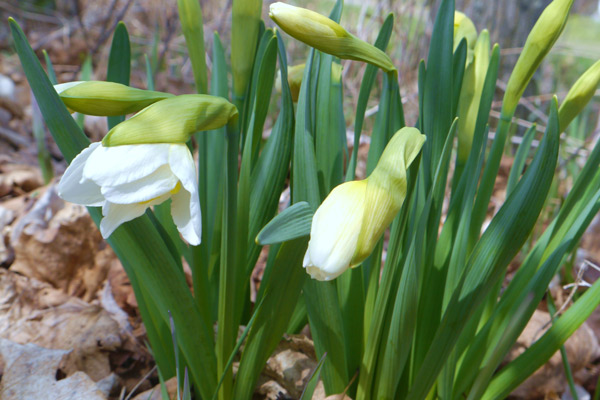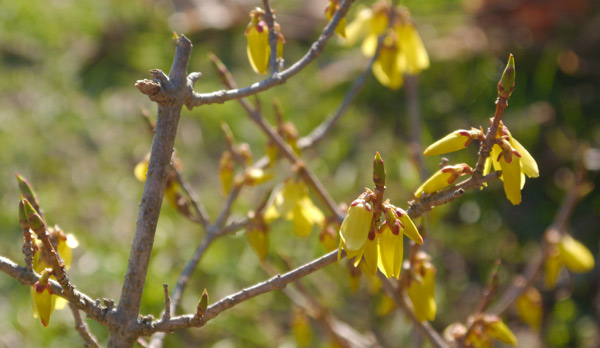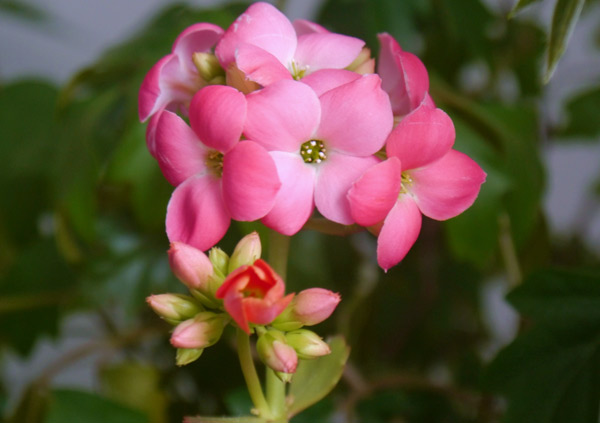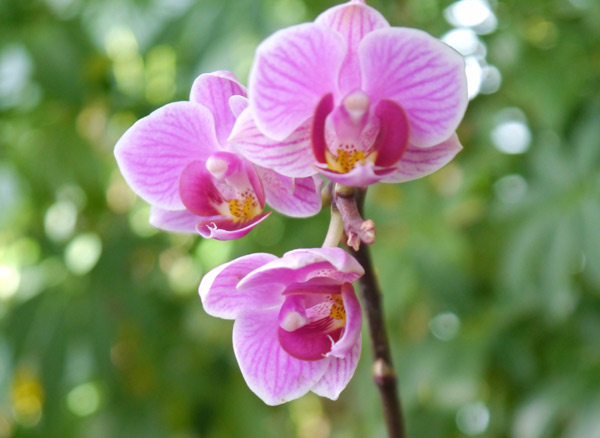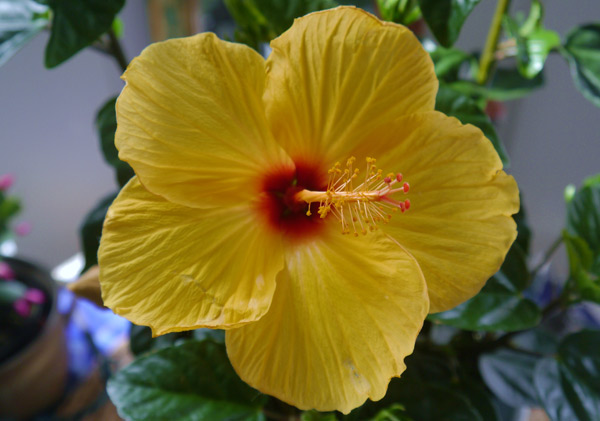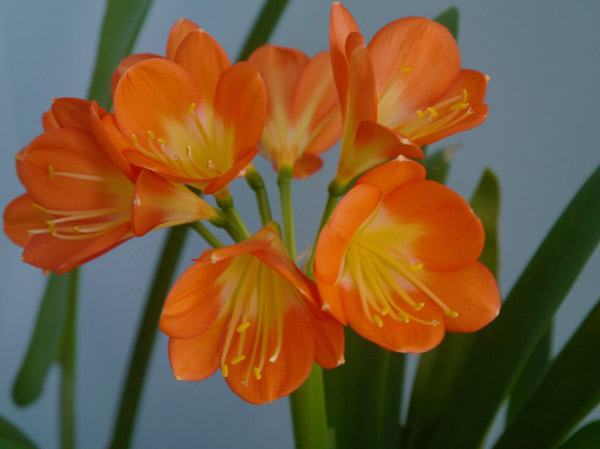Of birds, budding bulbs and indoor blooms (and baby bloom)
Administrator | Apr 27, 2025 | Comments 0
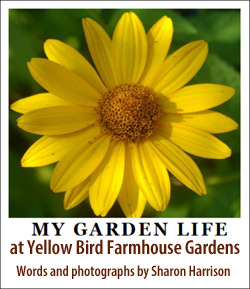 Bird activity in the late April garden is intense and often interesting, not as intense as it will be in the hopefully warmer month of May, but it’s a great time for watching a variety of birds return to the garden, as well as observing bird behaviour.
Bird activity in the late April garden is intense and often interesting, not as intense as it will be in the hopefully warmer month of May, but it’s a great time for watching a variety of birds return to the garden, as well as observing bird behaviour.
It’s pure delight to hear joyful birdsong, especially early in the morning, where nothing compares to the unique repertoire. With no other sounds to disturb the melody at this otherwise quiet hour (sometimes just prior to sunrise), the ear picks up on different tunes, different pitches, the overall harmony one of pure tranquility and I marvel at how there is no other sound quite like it.
While there is a good presence of birds through the winter garden (cardinals, chickadees, mourning doves among them), many more appear or arrive through April, and even earlier in March in some cases, even before the anticipated spring migration of songbirds which comes later in May. One of the first signs begins with returning robins (about a month ago) which tends to signify to all the others that it’s a good time to come back.
Starlings gather as starlings like to gather, often in large numbers, where along with robins they like to pick and pluck at the grass, stabbing the lawn with their beaks (where I welcome the aeration the holes provide) likely looking for a docile worm for lunch. Not only is it a time for nest-building as leaf litter, bits of twig and other nest-building materials are sorted and gathered and flown away in clenched beak, it is also an often humorous time when it comes to bird dating and ultimately mating.
Watching one bird in pursuit of another, determined, persistent, sometimes dramatic with lots of dancing and prancing and chasing, squawking, squeaking, the funny frolicking continues. One bird pestering another, sometimes several pestering one, in what is mating season, the behaviour funny to watch as I let it entertain me for a few minutes. Some (presumably females) appear to enjoy being pursued, others clearly don’t, their resistance obvious (and maybe futile), or perhaps it’s all part of the chase, but in any event, it certainly makes for some amusing entertainment for the humans watching it all unfold.
The gentle cooing sound, hauntingly beautiful and symbolic, where mourning doves are seldom seen alone, the pairs often together as they gently coo to each other, sitting atop a wire or on the ridge of the house, preferring these locations rather than a tree branch it seems. There are cardinals of course which have been around all winter long, squawky noisy blue jays, sweet chickadees, sparrows, common grackles and many others.
While the early spring garden is slim on colour, daffodils are beginning to bloom, some still a week or so away from showing colour, where all seem slow to perform in what has been a cool April. With a few warmer days recently, they are beginning to catch-up where change can now be observed daily in the garden as forsythia is blooming, where even lilac buds display a hint of purple colour, a tease of what’s to come.
Indoor colour, however, is not in short supply and that is where my attention, and enjoyment, is drawn. Much to my delight, many flowering houseplants decided to bloom almost at the same time, whether by design or default, the house is full of colour.
A beautiful yellow hibiscus (one of my absolute favourites), several orchids, an Easter (or Christmas) cactus, kalanchoe, as well as clivia miniata (belonging to amaryllis family) which started things off many weeks ago. But it is the pure white amaryllis that have just started to bloom that simply astound.
Bought about five or so years ago as a bare bulb, it has flowered regularly, usually once a year, sometimes twice a year, until the bulb grew so large, it burst out of its pot, distorting the round pot into something more oval-shaped. It desperately needed repotting, which I finally managed to get around to doing about 18 months ago. Along with growing really big, the bulb produced a baby bulb which wasn’t a separate bulb, but was attached to the mother bulb. A first for me with amaryllis, and a dilemma to figure out.
I figured two bulbs together wasn’t going to work long-term, and for the longevity of the bulb, one brave day I took a serrated bread knife, separated the two bulbs in a careful kitchen counter surgery, and ended up with two odd-shaped butchered bulbs that looked like they had just undergone surgery (which they had). Each distorted bulb piece was potted up in its own pot and I had no idea if either would survive (fairly certain mother bulb would, but less convinced the baby would), all while wondering if I was even doing the right thing. Both did survive.
I knew the bulb surgery would put the thing into shock for a while because this wasn’t simply repotting a bulb, but cutting into a bulb, so I knew I had to be patient. Even leaf production was in short supply, and while clearly alive (the bulbs firm and otherwise healthy looking), depleted of energy, they have not flowered or really done anything in 18 months, until now.
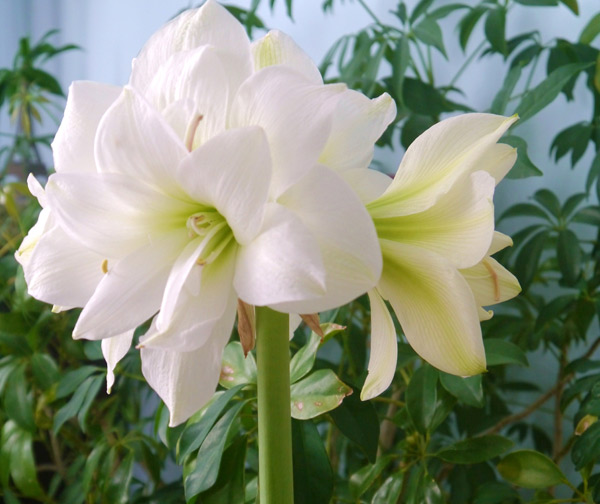 Mother bulb produced two flower stalks, a toweringly large (and thick) main stalk at 25 inches tall with four large trumpet-like flowers and a smaller stalk from the same bulb (growing out at an angle) at about 15 inches tall (the flower bud yet to open). The second (baby) bulb, much smaller in size, has an impressive 21-inch stalk with three flowers atop. So, my one bulb is now two bulbs and I have three flower stalks loaded with blooms (who are all impressively standing by themselves with no staking necessary), all of which decided to start blooming, as if on cue, on Easter weekend, where amaryllis became amaryllises.
Mother bulb produced two flower stalks, a toweringly large (and thick) main stalk at 25 inches tall with four large trumpet-like flowers and a smaller stalk from the same bulb (growing out at an angle) at about 15 inches tall (the flower bud yet to open). The second (baby) bulb, much smaller in size, has an impressive 21-inch stalk with three flowers atop. So, my one bulb is now two bulbs and I have three flower stalks loaded with blooms (who are all impressively standing by themselves with no staking necessary), all of which decided to start blooming, as if on cue, on Easter weekend, where amaryllis became amaryllises.
– A gardener all her adult life, and much of her childhood, Sharon Harrison blames her parents for this predicament, both of whom are life-long gardeners and growers of good things, nonetheless grateful for the gardening genes, and the growing passion.
While she has written on countless topics over many years for numerous publications and media, her heart remains rooted in her Prince Edward County garden as a grower of beautiful, strange and sometimes ordinary things, inspired and influenced by nature, wildlife and the fragility of environment.
Filed Under: News from Everywhere Else • Sharon Harrison
About the Author:



